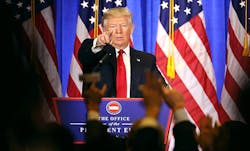Welcome to part 2 of my 3-part blog series, which discusses how the Trump administration might impact environmental, health and safety regulation.
The first post in this series talked about Trump’s appointees to run the Department of Labor, Andrew Pudzer, and the EPA, Scott Pruitt. Both appointees appear to be anti-regulation and likely will take steps to weaken the regulatory impact of both agencies.
In this post, I’ll discuss the facts and political realities likely to confront the Trump administration and his appointees regarding potential efforts to roll-back current EHS regulations.
Let's begin by summarizing Trump’s stated objectives and policies regarding regulatory reform. I've taken some time to review Trump’s website to see what it has to say about the subject:
Regulatory Reform
A quick review of the Regulatory Reform section of the website reveals the following summary policy points:
- Temporary moratorium on ALL new regulations.
- Canceling of “over-reaching” executive orders.
- Review of all current regulations to eliminate ones that kill jobs and bloat government.
The section includes this interesting summary statement: “While reasonable regulations are needed to address issues ranging from ensuring public safety to ensuring proper stewardship of our National Parks’ crown jewels, this can be accomplished without the profound damage to our economy and our freedoms that is currently inflicted by the regulatory bureaucracy. The Trump administration is committed to regulatory reform that will produce sensible regulations that allow America to be great.”
The statement is broad and wide open to interpretation. For example, does “ensuring public safety” include the safety of private sector workers? Do Trump and his appointees believe that current EHS regulations that impact industry and small business are “reasonable,” or that they “kill jobs and bloat government?” Only time will tell…
Temporary Moratorium on New Regulations
This objective is relatively straightforward, although it’s unclear what “new” means. Does this apply to regulations that went into effect towards the end of the Obama administration, after the election date or after Trump’s inauguration?
For example, OSHA just implemented three new major rules addressing recordkeeping and reporting, silica and walking/working surfaces. Apparently, at least two of these new rules are recent enough to potentially get targeted by Trump administration for change or repeal via the Congressional Review Act (CRA), in which lawmakers have 60 legislative days to overturn a regulation from the administration (or previous administration).
Regardless, once the new administration takes office, this is one area where it could influence any recent regulations that have yet to go into effect or proposed new EHS regulations.
Cancelling Over-Reaching Executive Orders
I did some research and couldn’t find any executive orders relevant to EHS other than one for EPA, which ensures a smooth transition if senior leadership dies, or for some other reason can’t perform their duties. This order doesn’t appear to be over-reaching.
Review of Current Regulations to Eliminate Ones that Kill Jobs and Bloat Government
This is a very broad agenda statement, but based upon campaign talk, and from a common sense perspective, is probably aimed at much larger regulations that have far-reaching, major impacts on the economy and jobs. Things like climate change, tax reform, the Affordable Care Act, immigration reform, raising the minimum wage, etc. Then again, there’s no guarantee that Trump, Pudzer and Pruitt won’t also target existing environmental, health and safety regulations. The remainder of this article will focus on this issue and the probability of success if the administration pursues this course of action.
Again, Trump promised major regulatory reform during his presidential campaign, but campaign promises are one thing, and governance is often quite another….
In a recent interview recounting his discussions with Trump regarding the transition process, governance and the realities of Washington, President Barack Obama stated that after taking office, he soon realized that “the federal government and our democracy is a not a speedboat, it is an ocean liner.” He added, “This office has a way of waking you up.” He said that Trump’s positions or predispositions that don’t match up with reality will be “shaken up pretty quickly, because reality has a way of asserting itself.”
Recall Obama’s campaign promises to create a long term-stable clean energy policy, immigration reform, an emissions cap and trade system to combat climate change, closing the Guantanamo bay prison, etc.? None of these promises materialized during Obama’s presidency.
What follows is a summary list of political, legal and other obstacles standing in the way of potential EHS regulatory reform efforts by the Trump administration.
Choosing battles. As stated previously, Trump and his appointees are most concerned with rolling back major regulations that create significant and undeniable burden and consequences for the economy and jobs. These include regulations related to climate change, the Affordable Care Act, immigration and increasing the minimum wage.
If Trump plans on attacking these issues, they’re going to be major fights requiring extensive time, resources and political capital. No easy task, even with a congressional majority. If his administration chooses this path, there may not be much left in the tank for confronting changes in EHS regulations. As any politician knows, success requires that you pick your battles.
Most existing EHS regulations are long-established and have proven to be effective in reducing unhealthy environmental emissions, workplace hazards and injuries – Current federal and state EHS regulations that impact industry and small business are long-standing and well-established. Many OSHA regulations date back to the early 70’s and many EPA regulations date back to the early 80’s and earlier. In other words, they’re long since “baked” into industry, largely accepted and proven to be effective.
Moreover, most of these laws are intended to provide baseline preventative measures to protect the environment, local communities and worker safety, and don’t create excessive burdens for business. As a powerful example of the effectiveness of these laws, OSHA reported in October of this year that national injury and illness rates have dropped every year for the past 13 years, with the exception of 2012, with a significant drop from 2014 to 2015.
As part of the press release, Dr. David Michaels, the former assistant secretary of labor/OSHA stated: “We are encouraged to see the significant decline in worker injury and illness rates. This is the result of the relentless efforts of employers, unions, worker advocates, occupational safety and health professionals, and federal and state government agencies ensuring that worker safety and health remains a top priority every day.”
Do Trump and Pudzer really want to risk reversing this trend? What good could come of this?
Add it all up, and it’s easy to see how starting a campaign to repeal or change these laws could appear to be reckless at best, and dangerous and irresponsible at worst.
Department heads come and go, but career public servants do not. How cooperative do you think the “rank and file” agency bureaucracy would be towards unreasonable change? Department heads come and go, but agency staff often remain throughout multiple administrations over time, and that’s because most public servants strongly believe in their agency missions and support the laws they administer and enforce.
Staff members must follow management direction and do as they’re told, but there’s no guarantee that they’ll do so enthusiastically or effectively. Any efforts to undermine agency mission likely would result in serious damage to morale. Sure, Pudzer and Pruitt can install new management and shuffle staff, and probably will, but they can’t fire and replace the entire staff, and those who remain probably won’t make change easy. Add it all up, and it’s easy to imagine how civil servants could seriously undermine any administration efforts towards change.
Lax EHS enforcement can lead to disaster. Recall the recent EHS-related disasters at Flint, the Deepwater Horizon and West, Texas? Each of these events later was tied to regulatory failures; either lack of regulation or failure to follow or enforce existing regulations.
Would it be wise to roll back EHS regulations that could have prevented these disasters, and thus potentially result in similar catastrophes in the future?
Federal vs. state regulation. Some states answer to federal OSHA while others fall under state programs that must meet or exceed federal OSHA. Similarly, EPA dictates federal environmental laws, while each state has its own environmental agencies that must meet or exceed those federal standards.
Puzder and Pruitt could initiate federal-level changes, but how long would it take state-operated programs to follow suit and would they, given that their programs must meet or “exceed” federal programs?
On a related note, Pruitt is on record in support of state level governance and regulation, so he’d be hard-pressed to try to weaken EPA regulations and expect states to follow suit.
Administrations can’t unilaterally rescind regulations. Despite Trump’s campaign promises to rescind regulations that “kill jobs and bloat government,” Supreme Court precedent shows that new administrations can’t unilaterally rescind federal regulations without due process. There must be a strong, rational argument for making the change. The Supreme Court has prevented past efforts to de-regulate by ruling that rationale was “arbitrary and capricious.”
In summary, all proposed regulations must go through an extensive rulemaking process, which includes public notice, comment and sound rationale explaining why the regulation is needed. It also includes the SBREFA process. In 1996, Congress passed the Small Business Regulatory Enforcement Fairness Act (SBREFA) in response to concerns expressed by the small business community that federal regulations were too numerous, too complex and too expensive to implement. SBREFA was designed to give small businesses assistance in understanding and complying with regulations and more of a voice in the development of new regulations.
Taken together, this is a very time-consuming, resource-intensive and expensive process that every regulation must “pass” prior to becoming law. In addition, any efforts to rescind or rewrite EHS regulations likely would be met with stiff and determined legal resistance from various stakeholders. These legal battles can and have taken years to resolve.
Add it all up, and existing EHS laws – both federal and state –likely are “safe” from significant change or elimination by the new administration, despite Trump’s promises.
The Future of EHS Regulations
So where does this leave the overall EHS regulatory reform potential? The issue really comes down to two things: 1) enforcement and 2) limiting expansion of existing or new regulations. These are the two areas susceptible to influence by the new administration, and Pudzer and Pruitt likely will act on both.
As it is, OSHA, EPA and state environmental agencies enforcement departments already do not have the resources to adequately inspect every U.S. workplace even once in the next 10 years. That’s always been the situation, regardless of administration, and won’t change. So in reality, regardless of what the Trump administration does, the overall risk of enforcement action for any given company isn't going to change much.
It’s not hard to imagine both appointees cutting enforcement budgets and installing administrators who are focused on voluntary compliance and not mandatory enforcement. This would reduce the number of enforcement inspections and fines, but might positively impact workplace safety. It’ll be interesting to see how far they go, especially given Trump’s quotes in support of “reasonable” regulation, and pledges to protect workers and the environment.
Neither Pudzer and Pruitt are likely to propose a lot of new EHS regulations, absent any major disasters or events that might trigger the need for new regulation (ie: another major oil spill, contamination or high-casualty industrial event).
Trump has made some big regulatory reform promises that he may or may not be able to keep. The regulatory targets for his administration likely are the ones that have undeniable consequences for the economy and jobs, such as the Affordable Care Act, climate change, immigration, financial and tax reform, not existing, long-standing EHS regulations.


